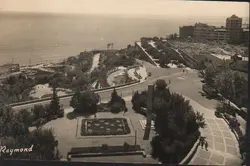

“La Fresca del Fòrum”, located on the corner of Calle de la Merceria and Plaza del Fòrum (in the Part Alta), is the oldest bacalanería in Tarragona. Founded in 1942, also as “Cal Pagès” in that post-war period marked by ration cards, it would begin its journey without any sign to identify it, but the store was popularly known as the “Pepeta del bacalao” store. There, in a space of just over eighty square meters that was divided between a store and a home, Mrs. Pepa would make the business prosper and, with her husband, they would have and raise her children. Carme, one of her daughters, would take over the business, until in 2005 she would retire and close it. Then eight years of silence would come (2005-2013), until Neus Bosch (former Social Integration Technician of the Tarragona City Council and current owner of the business), rescued it from oblivion.
DURING THE DECADE OF THE 40'S AND 50'S OF THE LAST CENTURY, THE FORUM SQUARE WAS STILL A BUMBLING OF COMMERCIAL ACTIVITY THAT SUPPLIED BEYOND THE UPPER PART
Neus and Josep - a resident of the neighborhood and a regular customer of the bacalanería - explain that during the 40s and 50s of the last century, the Plaza del Fòrum was still a hub of commercial activity that extended beyond the Part High. They say that in the Plaza del Fórum there was a daily market for fruits, vegetables and meat. And in the Peixateries Velles square, for fish. They explain that, in those years, the effects of the almost 300 bombings that the city had suffered during the Spanish Civil War (1936-1939) were still visible, and that some destroyed buildings would not be cleared until fifteen years after the conflict. In that landscape, Neus and Josep stand out, life and death went hand in hand: the smell, the color of the food, the noise of the people, and the sinister silhouette of the half-collapsed buildings that permanently reminded us of the dead, those who were shot, those who were retaliated against and those who were exiled.
Josep (born in 1947 in Aleixar and resident in Tarragona since 1949) explains that in Plaza del Fòrum and Calle Merceria there was a very powerful and varied commercial and service offer. The “Pepeta del bacalao” was joined by two other bacalanerías -now disappeared-; five bread ovens -of which only one remains-; several grocery stores - "Cal Corderet" stands out, which for years complemented its traditional chandlery activity with the sale of groceries; various butcher shops - which, except for one, have not stood the test of time -; and three prostitution bars - which have also disappeared. They say that there was no type of conflict, and that all businesses were fully integrated into a scenario of good neighborliness that, in that time of misery, illness and death, had generated a compact network of solidarity.
Neus Bosch, the current owner, born in the old town of Gràcia and resident in Tarragona since she was 19 years old, had been responsible for the Comprehensive Plan of the Upper Part: detection and attention to social problems (older people living alone) ; and structural problems (housing that suffered severe degradation and endangered residents and pedestrians). In this way she came into contact with the bacalanería, which had already been closed for some time. Neus explains that, when she entered, she found the entire history of a family of shopkeepers in the form of counters, shelves, scales, cutters and knives; unfortunately degraded by time and abandonment. The task of recovering the space would be very expensive, but with a lot of effort she-she affirms she-she would ensure that "it is the Pepeta del bacalao" - adapted to current events - would become a living store again.
WHEN YOU ENTERED, YOU FOUND THE ENTIRE HISTORY OF A FAMILY OF STOREKEEPERS IN THE FORM OF COUNTERTOPS, SHELVES, BALANCES, CUTTERS AND KNIVES
Neus explains, anecdotally, that during the rehabilitation works, the bricklayers “discovered” a piece of gallery probably excavated in medieval times, which at least crosses the square towards the wall: “one more of the many tunnels that They connected the powerful houses with outside the walls, to escape when things got tough,” he says. And, let us not forget, the current Plaza del Fòrum had been, until 1811, the Patriarch's castle, the residence of the archbishops of Tarragona. Since 2013, “ca la Pepeta del bacalao” is “La Fresca del Fòrum”, a name that Neus found easy to retain and, at the same time, explained his commercial project: cod and marinades (olives, pickles, onions and garlic); and everything she has incorporated into the counter: pickled anchovies, fresh cod, cod spill, and fresh and cured cheeses and sausages.
Josep explains that, when he was little, he saw that the men who worked around him bought a "lengüet" of bread for lunch in some of the ovens in the square, went to "ca la Pepeta del bacalao" and had a sardine put in, a herring or a piece of tuna. Neus wanted to recover this tradition, but adapt it to current times: it is also a bar that serves decorated slices. And he comments that they are visitors from Aragon, the Basque Country or Castilla; who most appreciate this offer. He also explains, a funny point, that some of these foreign customers have made the observation that the name of the business surprised them: “fresh” in Spanish has a second meaning. And he also explains that little by little he has been recovering the clientele of the old bacalanería, the children of this clientele, and that of families that have settled in recent years in the Part Alta.
OUR HISTORY
“Cal Pagès” and “La Fresca del Fòrum”: The oldest bacalanerías of Reus and Tarragona
 |  |  |
|---|---|---|
 |  |  |